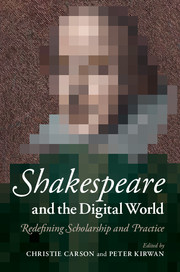Book contents
- Frontmatter
- Contents
- Notes on contributors
- Acknowledgements
- Shakespeare and the digital world
- Part I Defining current digital scholarship and practice
- 1 Shakespeare in the digital humanities
- 2 Getting back to the library, getting back to the body
- 3 Sensing the past
- 4 Webs of engagement
- Part II Defining current digital scholarship and practice
- Half-time: A pause for reflection
- Part III Redefining the boundaries and practices of Shakespeare studies online
- Part IV Redefining the boundaries and practices of Shakespeare studies online
- Index
- References
3 - Sensing the past
Tablets and early modern scholarship
Published online by Cambridge University Press: 05 July 2014
- Frontmatter
- Contents
- Notes on contributors
- Acknowledgements
- Shakespeare and the digital world
- Part I Defining current digital scholarship and practice
- 1 Shakespeare in the digital humanities
- 2 Getting back to the library, getting back to the body
- 3 Sensing the past
- 4 Webs of engagement
- Part II Defining current digital scholarship and practice
- Half-time: A pause for reflection
- Part III Redefining the boundaries and practices of Shakespeare studies online
- Part IV Redefining the boundaries and practices of Shakespeare studies online
- Index
- References
Summary
In his essay ‘The Presidigitator: A Manual’, Christof Migone suggests that ‘touch has become synonymous with the genuine, the real, the human’ (2004: 1). Merleau-Ponty asserted that the ‘intimate relation between sight and touch allows a sense of immersion in the world’ (cited in Paterson, 2007: 88). More recently, Juhani Pallasmaa observed that ‘Touch is the sensory mode that integrates our experience of the world with that of ourselves’ (2005: 11). This chapter is interested in how the iPad or mobile tablet creates the perception of the ‘genuine’, ‘real’ and the ‘human’ while it enables an immersive relationship for scholars with early modern texts and images through the sense of touch. As I begin writing this chapter on my iPad during my train journey to work, I think about the convenience of mobile tablets and their materialisation of the notion that everything can be found ‘at our fingertips’. As a scholar of Shakespeare and early modern cultural history, my research practice has never been one characterised by convenience and it has often been the case that I did not have all the resources I needed at my fingertips. In this chapter, I will explore how the iPad has the potential to intervene into research practices, specifically here for scholars of early modern literature or history. Thinking this through with sensory theory or haptics (relating to the manipulation of objects using the sense of touch) and discussing the importance of tactility to researching historical texts, this chapter will argue that touching and manipulating the early modern canon is a scholarly practice that the iPad simultaneously promises and denies.
- Type
- Chapter
- Information
- Shakespeare and the Digital WorldRedefining Scholarship and Practice, pp. 33 - 42Publisher: Cambridge University PressPrint publication year: 2014
References
- 1
- Cited by

